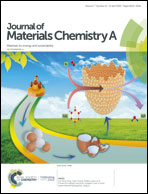Ultrathin 2D metal–organic framework (nanosheets and nanofilms)-based xD–2D hybrid nanostructures as biomimetic enzymes and supercapacitors†
Abstract
2D metal–organic frameworks (2D MOFs), which combine the advantages of 2D materials and MOF, exhibit great potential for application in catalysis, sensors, supercapacitors, biomimetic enzymes, etc. However, due to their coordinate forms and size of their coordination structure, the preparation of ultrathin 2D MOF is challenging. In this work, ultrathin 2D MOF M-TCPP (M = Cu, Co and Ni) nanofilms and the corresponding 2D MOF M-TCPP nanosheets were synthesized in the presence and absence of PVP. The thickness of the 2D M-TCPP nanofilms was ∼2 nm, which is much thinner than most reported 2D MOF structures. Significantly, to overcome the limitations of pure 2D MOFs (poor conductivity and aggregation), xD–2D hybrid nanostructures (1D–2D M-TCPP nanofilm/CNT and 2D–2D M-TCPP nanosheet/GO) were fabricated based on the corresponding 2D MOF, and the electrochemical properties of the obtained xD–2D hybrid nanostructures towards the application of biomimetic catalase and supercapacitors were researched systematically. In biomimetic catalase applications, the Langmuir–Schäfer method is used to fabricate platforms for the electrochemical detection of H2O2. Among the samples, Cu-TCPP nanofilm/CNT/GCE (n = 4) exhibited the best catalytic activity toward the reduction of H2O2 with an extra low detection limit of 5 nM and good linear range of 0.01–3.75 μM and 3.75–377.75 μM, which was successfully used for real-time tracking of H2O2 in live cells. In supercapacitor applications, Ni-TCPP nanofilm/CNT exhibited the best properties with a large specific capacitance of 2280 F g−1 at a current density of 5 A g−1. Our work provides a universal strategy for the fabrication of xD–2D hybrid nanostructures based on 2D MOF nanomaterials to overcome some of the limitations of pure MOFs in specific applications, and shows a futuristic approach towards H2O2 sensing and energy storage.



 Please wait while we load your content...
Please wait while we load your content...